A Small School’s Project Is BIG For The Community
A $2 million outdoor facilities renovation has moved Sauk Centre out of the past
There is an enduring image of Roger Bannister breaking the string at the finish line on a dirt track while completing the first recorded mile in less than four minutes. This was in 1954. As decades passed, running tracks evolved and this past summer when Usain Bolt won both the 100- and 200-meter events, he did it on a track surface made of rubber.
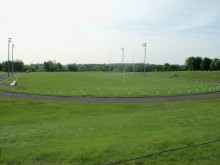 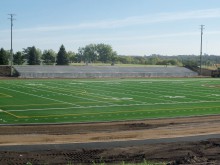 |
| Sauk Centre Secondary School (Minn.) is the smallest school in the state (about 300 students) with turf in its football stadium. Sauk Centre previously played on a grass surface, which would freeze in the cold Minnesota temperatures. (Before: left, After: right). |
For the athletes at Sauk Centre Secondary School in Minnesota (located slightly more than 100 miles northwest of Minneapolis), their track experiences have been closer to that of Bannister … minus the four-minute miles. Saddled with a dirt track, which conjures up memories of generations past, Sauk Centre’s track team hasn’t hosted a meet since the mid-1980s.
That finally is going to change … and then some. Spurred by a desire to replace its ancient track, Sauk Centre is in the process of completing a $2 million renovation project at its small school (roughly 400 students in grades nine through 12). Once finished, Sauk Centre will have the following updates:- A new, eight-lane track made of a high-quality BSS 1000 surfacing from Beynon
- A new FieldTurf football field, making Sauk Centre the smallest school in the state to have turf in its football stadium
- New bleacher seating for 1,000 to 1,200 people in the football stadium
- A complete overhaul of the school’s eight tennis courts, which previously had numerous cracks
- New irrigation, fencing and scoreboards for the softball and baseball field
“The impetus for the discussion of a renovation came from wanting to redo the track,” explains Sauk Centre superintendent Dan Brooks. “From there, we found that if we wanted to do the track project, we also had to redo the football field for drainage and safety maintenance.”
Getting Started
All great renovation projects start with an idea, then need money. For Sauk Centre, replacing the track was a long time coming, as was updating the outdoor athletic facilities.
“We knew we had some issues with our outdoor facility lacking,” says athletic director Rick Fischer. “Our softball field was adequate. Our baseball field was not. Our track was made of dirt. Our football field was in a nice valley setting but didn’t hold up.”
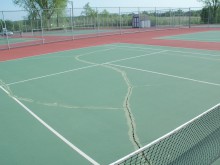 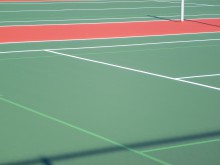 |
| The eight tennis courts at Sauk Centre Secondary School have been completely revamped. Now, players aren’t dealing with bad bounces off cracks in the surface. (Before: left, After: right). |
The basis for the renovation was well documented, but then came the task of securing the money to get the projects done. The initial “seed money” as described by Brooks and Fischer came from the sale of an off-site building, which previously housed after-school programs and special education offices. Those programs then were moved on-site (the Sauk Centre campus contains buildings for the elementary school, the junior high school and the secondary school) and the building was sold for $365,000. Brooks explains an additional $915,000 came from the sale of capital facility bonds. In Minnesota, school districts may issue general obligation bonds to finance some facility renovations and repairsthese bonds do not require voter approval (under Minnesota Statutes Section 123B.62). Brooks cited information showing these bonds result in lower interest rates than most other forms of borrowing.
Other contributors to the bottom line number of $2 million included deferred maintenance money, donations and fundraisers.
A Fast Process
Once the funding was in place, Sauk Centre officials began making extensive site visits, convening focus groups and speaking with manufacturers this winter.
“We’d put together groups of eight or nine people to go on these site visits,” says Fischer who adds having a lot of people asking questions helps make each site visit more efficient and effective.
Making these site visits in the winter also paid dividends. This is central Minnesota at its absolute coldest, so being able to feel the softness of a turf field or new track with the temperatures at or below zero degrees provies a real difference when going back to the community and trying to sell them on the advantages of these products.
“We made a site visit on Feb. 2 and it was brutally cold, but that field was soft,” Fischer recalls.
Brooks adds the site visits confirmed his view that turf is a safer surface for athletes playing in the numbing temperatures of Minnesota. “By late October, early November, our ground freezes. Having a softer surface places less pounding on our players.”
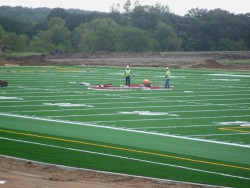 Despite the best efforts of the engineers and contractors, Sauk Centre’s football stadium was not ready for the Sept. 7 opener. Rick Fischer, the athletic director, worked months ahead of time with the two opponents scheduled to play at Sauk Centre in early September to develop a contingency plan. |
Armed with the knowledge from the site visits and the pitches from the manufacturers, Sauk Centre officials moved quickly so all projects could be scheduled during the summer months. Bids were approved on May 15 and the digging began within the week.
“This was a six- to eight-month project we wanted to get done in three to four months,” Brooks says. “To make our deadlines, we needed a great deal of persistence, cooperation and preplanning.”
Plus, the Midwestern drought, which devastated farmers in the region, actually worked in Sauk Centre’s favor. Brooks says they only lost one morning of work due to rain, so the projects pushed ahead quickly.
Choosing Turf
For a school of 300 or so students, a turf field seems like a luxury. But, when comparing the pros and cons, the usage and the weather in Minnesota, both Fischer and Brooks rallied behind the idea of a turf field, especially when the community showed its support in the meetings leading up to the decision.
“We figured we’re only going to do this once, so we wanted the best option we could afford,” Brooks explains. The main issue from the community, oddly enough, came from residents who attended the team’s sectional finals football game last year in the Fargodome, which has a type of turf not under consideration at Sauk Centre. “The turf at the Fargodome is very hard, so we had to convince people not all turf is the same. We actually had samples of our turf in our office so people could come in and touch it.”
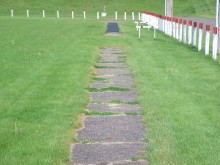 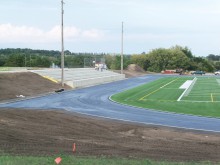 |
| After decades of running on a dirt track, athletes at Sauk Centre Secondary School now will be racing around a polymerblend track to allow the school to hose track meets and generate additional revenue. (Before: left, After: right). |
“We originally were going to resod the field, but then we made our site visits and were told their turf fields were in use from 8 a.m. until 8 p.m. some days,” says Fischer. “Add in not having to irrigate and housing all our physical education classes on it, and it became a logical plan for us.”
Fischer adds that even though Sauk Centre doesn’t have a soccer team, the turf field installed at the school actually is lined for soccer. “Our P.E. classes are going to use this field for soccer and we now have the ability potentially to host sectional soccer games, which could be a revenue generator for us.”
Track, Baseball & Softball
Just like with the turf football field, when considering a track surface, Brooks explains the board and community had cheaper options before them but ultimately decided upon the BSS 1000 from Beynon. It’s a polymer blend, which goes through a different application process in that it is poured on, spread out and eventually painted.
“You can feel the pliability difference with this track,” Fischer says. “With our track season starting in March (when the average high temperature is 38 degrees F and the low is 18), having a soft surface is important.”
As for the baseball and softball fields, both required major work. Fischer says last season he attended a home baseball game and was shocked to see a ball hit to the outfield take a wild bounce two feet away from an outfielder who should have had a perfect line on it if the field was level. A lot of the issues with the baseball field had to do with the junior high school football team practicing on it.
“We tore down the baseball field from beginning to end. We put in a new infield, reseeded, added a new backstop and reshaped the mound,” Fischer explains.
The softball field wasn’t in as bad of shape but for every game the team had to drag a portable fence to the outfield. Fischer describes the old, portable fence as “basically a wind screen.” Now, a new, permanent, four-foot high fence surrounds the outfield. Irrigation work has been completed with a new backstop added, as well as seating for 300 to 400 people.
Building A Sense Of Pride
Beyond the concrete, steel, turf and polymer blends, what Sauk Centre truly created is a sense of pride for this community of 4,000 people.
“The school really is the center of the community here,” explains Brooks. “During this entire process, we’ve had people just standing outside the construction area and watching. There is a real pride in the community in what we are doing.”





